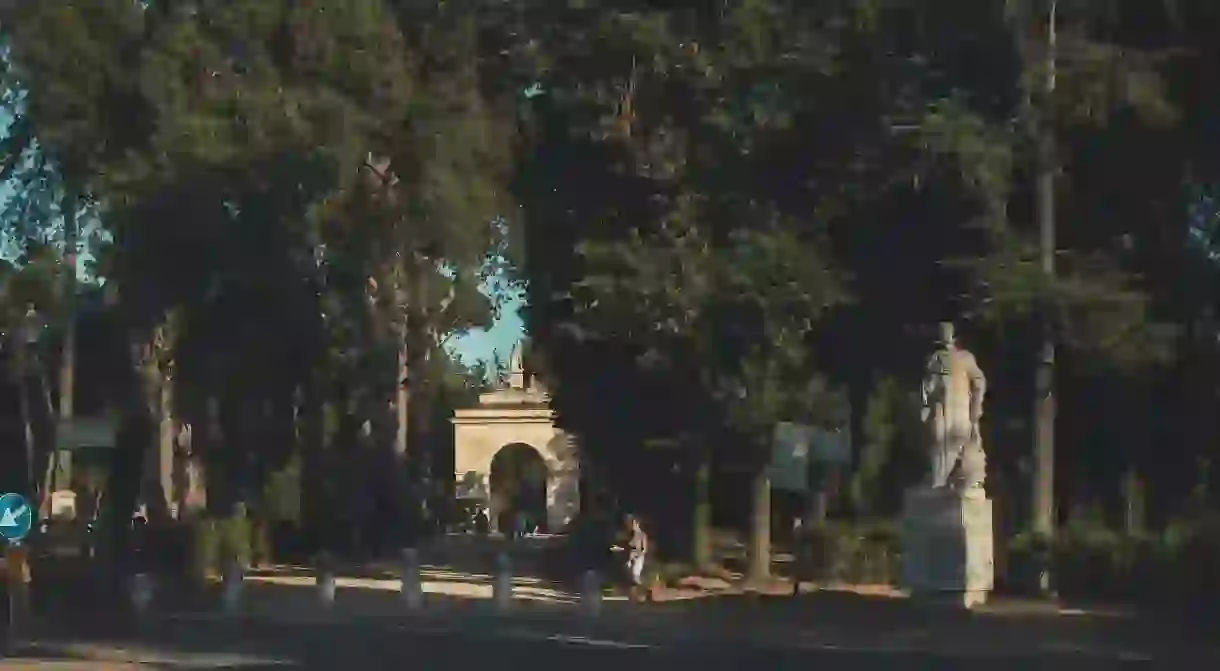The 8 Best Things to See and Do on the Via Veneto in Rome

Luxury hotels sit alongside celebrity haunts on Via Vento, one of the most expensive streets in Rome. Discover the must-visit sights in this historic part of the capital of Italy.
Via Vittorio Veneto was the starring location in Federico Fellini’s 1960 film La Dolce Vita, in which journalist Marcello Rubini trawls louche bars and high-class nightclubs for celebrity gossip. Follow in his footsteps with our guide to the top attractions in this exclusive area, including a cocktail joint overlooking St Peter’s Basilica, a legendary cafe and a crypt decorated with human skulls.
Marvel at the Fontana delle Api
Architectural Landmark
The understated Fountain of the Bees marks the meeting point of Via Veneto and Piazza Barberini and dates from 1644. Originally intended as a watering spot for horses, it was designed by Gian Lorenzo Bernini (1598–1680), a Neapolitan sculptor, architect, designer and painter who invented the baroque style of sculpture. Bernini’s more elaborate Fontana del Tritone (Triton Fountain) is situated in the middle of Piazza Barberini and was completed the year before the Fontana delle Api.
Stroll through Piazza Barberini
Architectural Landmark

A natural start or finish point for a stroll along Via Veneto, Piazza Barberini is named after an Italian noble family whose power reached its apogee in 1623, when cardinal Maffeo Barberini became Pope Urban VIII. It’s dominated by three works by the pioneering sculptor Bernini: the Fontana delle Api (1644), the Fontana del Tritone (1643) and the Palazzo Barberini, which now houses the National Gallery of Ancient Art.
Ponder Renaissance art in Palazzo Barberini
Historical Landmark

Explore the gruesome La Cripta dei Cappuccini
Cathedral
The darkest attraction in Via Veneto is found at number 27, beneath the early 17th-century St Mary of the Capuchins Church. Built for Capuchin brother Antonio Barberini on the orders of his brother Pope Urban VIII, these underground chapels are decorated with the skeletal remains of around 3,600 Capuchin brothers. As well as walls plastered with skulls and bones, there are two complete skeletons clad, Halloween-style, in the hooded tunics after which the order is name. Not for the squeamish.
Sip coffee in Cafe Doney
Cafe, Restaurant, Mediterranean, Italian
Tuck into a steak at Girarrosto Fiorentino
Restaurant, Italian
Fine Italian wine and premier steaks headline at Girarrosto Fiorentino, a Tuscany-inspired celebrity haunt that opened in the 1960s. Loosen your belt before tackling the 1kg (2.2lb) T-bone (serves two), which is finished by the waiter at your table, as is the fillet steak tartare. For the ultimate Fiorentino experience, start with their signature ribollita, a warming black cabbage soup that’s only cooked during the winter. A 400-label wine list features varieties from the oldest winemaking families in Tuscany.
Visit Villa Borghese
Botanical Garden, Museum

Sip a cocktail in Il Giardino Bar
Restaurant, Italian
For an early-evening aperitif with a view, head to Bar Il Giardino, situated on one of the highest floors of the five-star Eden Hotel. Take a seat on one of the leather sofas by the oversize windows, order a Martini Trevi – a lavender and bergamot concoction inspired by the historical gardens opposite – and gaze over St Peter’s Basilica. Accompany with artfully presented cicchetti (Italian tapas) by chef Fabio Ciervo.
Trips and Tours in Italy
Architectural Landmark

Planning your Italian adventures? Whether you’re keen on epic cultural cities like Rome, Milan and Florence, fancy some foodie experiences in Emilia Romagna and Tuscany, or dream of coastal fun all over Sicily, there’s a wide range of amazing itineraries to choose from on our extensive collection of multi-day tours in Italy.
This is an updated rewrite of an article originally by Alessandra Palmitesta.













